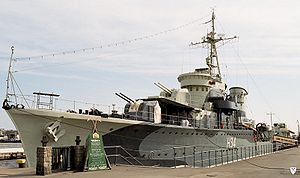ORP Błyskawica

ORP Błyskawica, modern view
|
|
| History | |
|---|---|
|
|
|
| Name: | ORP Błyskawica |
| Namesake: | lightning flash |
| Laid down: | September 1935 |
| Launched: | 1 October 1936 |
| Commissioned: | 25 November 1937 |
| Decommissioned: | 1 May 1976 |
| Honours and awards: |
|
| Fate: | Museum ship |
| General characteristics | |
| Class and type: | Grom-class destroyer |
| Displacement: | 1,975 tons standard |
| Length: | 114 m (374 ft 0 in) |
| Beam: | 11.3 m (37 ft 1 in) |
| Draft: | 3.3 m (10 ft 10 in) |
| Speed: | 39 knots (72 km/h; 45 mph) |
| Complement: | 192 |
| Armament: |
|
ORP Błyskawica is a Grom-class destroyer which served in the Polish Navy during World War II and is the only ship of the Polish Navy awarded the Virtuti Militari medal. It is preserved as a museum ship in Gdynia, and is the oldest preserved destroyer in the world.
She was the second of two Grom-class destroyers, built for the Polish Navy by J. Samuel White, Cowes in 1935–37. The Polish word błyskawica translates to lightning flash, while her sister ship, Grom, translates to Thunderbolt. The Grom class were two of the most heavily armed and fastest destroyers during World War II.
In 1934, the British shipbuilder J. Samuel White won a competition to design and build large destroyers for the Polish Navy, beating a proposal from fellow British shipbuilder Swan Hunter. (A design by the French shipyard Ateliers et Chantiers de la Loire had been rejected in 1933). An order for two destroyers of the Grom class was placed on 29 March 1935.
At the time of their construction, the Groms were amongst the fastest and most heavily armed destroyers to be built.Błyskawica was 114 metres (374 ft 0 in) long overall and 109 metres (357 ft 7 in) between perpendiculars, with a beam of 11.3 metres (37 ft 1 in) and a draught of 3.1 metres (10 ft 2 in). Displacement was 2,011 long tons (2,043 t) standard and 2,520 long tons (2,560 t) full load. Three 3-drum boilers fed steam to two sets of geared steam turbines which were rated at 54,500 shaft horsepower (40,600 kW), driving two propeller shafts to give a design speed of 39 knots (72 km/h; 45 mph). Main gun armament consisted of seven 120 mm (5 in) guns (50 calibre M34/36 guns supplied by Bofors of Sweden) in three twin and one single mounts, with an anti-aircraft armament of two twin Bofors 40 mm guns and eight 13.2 mm machine guns. Six 550 mm (22 in) torpedo tubes were carried, compatible with the French torpedoes used by the preceding Wicher-class destroyers. Anti-submarine armament consisted of two depth charge chutes with 40 depth charges, while rails were fitted to permit up to 44 mines to be carried. The ship's complement consisted of 180 officers and men.
...
Wikipedia
